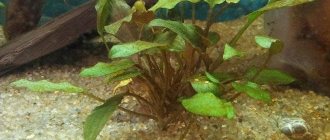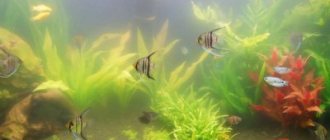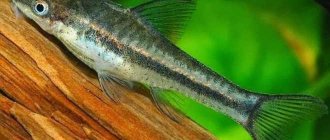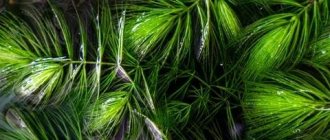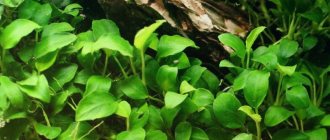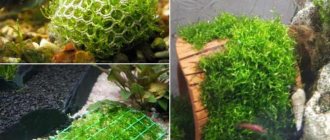Description
In reservoirs with an established biological environment, weeds are present in small quantities. It is worth worrying when faced with their rapid growth. Often a green coating appears on the walls of the aquarium, methods of combating which are discussed in a separate article. To combat lower vegetation in an aquarium, it is important to identify the type of algae. This way you are guaranteed to get rid of parasitic flora and not harm other inhabitants of the reservoir.
Reasons for appearance
- Violation or absence of biobalance. If there is a high level of organic matter in the aquarium (rotted grass, uncollected grass, fish waste and leftover food), the weeds have many food sources. Excess organic matter occurs due to overcrowding, infrequent aquarium maintenance and overfeeding of fish.
- Excess or deficiency of phosphorus and nitrates. Higher flora cannot cope with excess fertilizer, so phosphates and nitrates are consumed by algae. And also the lack of nutrients creates a favorable environment for weeds.
- Excess or lack of light. With long daylight hours, lower greenery absorbs excess light, and the plants weaken. The lack of light, in turn, creates conditions for the proliferation of some weed species.
- Incorrect lamp spectrum. Higher flora needs light in the blue and red spectrum. Weeds love the warm yellow light that incandescent lights and sunlight provide.
Brown or diatoms
Brown algae appears as plaque on the walls of the aquarium, leaves and soil. Harmless to flora and fauna. They often appear in the aquarium of beginners due to unstable biobalance and lack of light. Aquarium algae thrives in hard water with a pH above 7.5. To prevent growth, replace the bulb with a more powerful one or add another light source. If you don’t wipe off the brown plaque, it will form a thick layer that is difficult to deal with.
Red algae or black algae
They grow in tufts of gray, purple or reddish color, about 5 mm high. Also known as scarlets. They grow on all surfaces, in salt and fresh water. Purples are difficult to remove. They love hard water with strong currents. Preparations with glutaraldehyde are effective against them in combination with weekly water changes of up to 50% and thorough cleaning.
Vietnamese
The species is also called "stag antlers" because of the dark-colored branching tufts. Appears due to dead organic matter.
Black beard
Grows in black tufts. “Beard” is often confused with “flip-flop”, which is not a serious mistake, because the methods for getting rid of parasitic greenery are identical. If you notice that dark hairs have appeared on the plants in your aquarium, check out this article on methods to combat blackbeard.
Video on the topic
For information about the reasons for the appearance of green water in an aquarium, as well as ways to get rid of the problem, see the video below:
Blooming water is an indicator that indicates an unhealthy environment in the aquarium . Microscopic algae respond by thriving to changes in the aquarium environment, such as excessive lighting, increased water temperature or pollution. Following simple prevention rules will help prevent flowering, and this problem can only be dealt with by eliminating the cause.
- Related Posts
- Top 11 reasons why aquarium water stinks. What to do if an unpleasant odor appears?
- 11 reasons why the water in the aquarium becomes cloudy
- Has a film formed on the surface of the water in the aquarium? Not a problem, because there is a solution!
Greens
The group of green lower flora unites about 20 thousand species of unicellular and multicellular plants. Greenery inhabits mainly fresh water bodies.
Xenococus
Externally, xenococus appears as green dots on glass, forming a coating. Appears in densely planted herbal gardens and in half-empty aquariums. Causes: excess light and low carbon dioxide levels.
filamentous
Filament appears when there is a large amount of iron and a lack of phosphorus, which plays an important role in nutrition. Grows in thin interlacing threads. Easily removed mechanically.
Rhizoclonium
The light green weed looks like light cotton wool. Appears in aquariums with an unknown nitrogen cycle. Disappears after biobalance is established.
Spirogyra
It consists of fragile and slimy threads. It is difficult to get rid of algae as it grows at a high rate in the aquarium. The reason for growth is excess light and lack of nutrition. Turning off the lights in combination with introducing algae-eating fish and adding medications helps.
Cladophora
Weed with short filaments. It grows with weak filtration in stagnant water, as well as with a lack of carbon dioxide.
Difference between algae and plants in an aquarium
Blue-green algae
So for the aquarist, we can equate algae with plants. Sexual reproduction of plants, as a rule, does not occur in the aquarium.
Now again about the fight against algae in the aquarium. I can believe in the chemistry against blue-green algae, which is essentially bacteria. They can be killed with furazolidone. But I don’t know how you can kill algae without harming the plants.
And now I’m talking about coffee grounds. About the conclusions that I draw by translating the language of botanists.
Plants, due to their method of reproduction, conquered land. Their embryo comes with all the nutrients to begin growth. That is, for the first time it has nutrients to start growing. Algae don't have this. They must “pull” all elements from the external environment. Since they did not learn to “catch” their food in the air, they remained there - almost all of them in the water.
How to get rid of algae without causing severe damage to plants
Red algae
The plants in the aquarium are large. The algae are small. Plants can survive unfavorable conditions for them. Algae can't. Plants can tolerate stunting. Algae cannot withstand any kind of starvation. So comparing plants and algae is like comparing a giraffe and a caterpillar. Both have the same feeding process. Both eat leaves. If you poison a caterpillar, then if a giraffe eats such a leaf, it will also be poisoned. But! Take food from the caterpillar. How long will she live? A few days. And the giraffe? Month. This is what all treatment with drugs in an aquarium is based on - the algae will die, they cannot withstand changes, and the plants, although a little “cooked,” will survive.
Procedure for algae outbreak
Green Algae
As techniques to recommend if you already have an algae outbreak are inconsistent. Light break for 1 hour in aquarium lighting. Well, it’s like being in the sun for 8 hours in a row, or 2 times for 4 hours. It is normal for plants to apply 2 times for 4 hours. It is difficult for algae to understand why the flow of food is being interrupted. Also nutritional elements. There is a surplus, everyone eats together. Something is missing, the plants are tolerating it normally. But algae need it constantly and they cannot stand it. That’s why I pour fertilizer for aquariums once a week, and not every day, as recommended.
I can draw the following conclusion from this article. With algae, everything happens faster and they need consistency. Plants, in turn, “withstand experiments on themselves.” Here you need to feel the balance with experience. Every aquarium has algae. And you can’t escape them anywhere. And it's good that they exist. So look for balance rather than trying to “quickly” fix everything. For more details on how to remove algae from an aquarium, follow the link. If you need aquarium care, we in Kyiv are ready to provide it. Aquarium cleaning Kyiv.
Methods of fighting and getting rid of aquarium algae
For all types of algae, the manual removal method is relevant:
- collect weeds with your hands;
- wipe the glass;
- walk the siphon along the ground;
- wash the decorations;
- change some of the water.
Further, algae control is carried out using different methods:
- adjusting the light;
- planting higher plants;
- introduction of chemicals.
Remember that it is not enough to simply destroy the lower vegetation; it is necessary to eliminate the cause of the abundant growth.
Reducing lighting in an artificial pond
Darkening the aquarium is effective against Xenococus, Spirogyra, Euglena and blue-green cyanobacteria. Do not turn on the light for 2-3 days, darken the aquarium by throwing a cloth over the top. If there are light-loving plants in the pond, temporarily transplant them into another container with the required level of light. Do not turn off the aeration, because algae absorb oxygen. After exposure, remove dead flora and change the water. Use this method in conjunction with introducing algae-eating animals.
Application of fast-growing vegetation
Grasses crowd out lower greens, consuming all the nutrients from the environment. The method is effective against green and red algae. After exposure, the plants can be removed from the aquarium. Fast growing ones include:
- elodea;
- hornwort;
- cabomba;
- nayas;
- hygrophiles;
- lemongrass
Cryptocorynes and Anubias are not suitable.
Using algae-eating fish
Introduce pets that eat lower flora in combination with other control measures. Beneficial animals include:
- Siamese algae eater. Eats filamentous algae, xenococus and diamatous algae. He eats “flip-flop” and “blackbeard” less often if there is no other food.
- Malawian cichlids. They eat blackbeard, but can also eat higher plants.
- Catfish (Ancistrus, Otocinclus, Plecostomus). They are good at fighting brown and green algae, but sometimes they don’t mind eating the delicate leaves of anubias and lemongrass.
- Snails (horned snails, ampullaria, marises, coils, neretina). They eat brown and filamentous algae, including the difficult-to-breed spirogyra.
- Viviparous fish (guppies, swordtails, mollies, platies). Copes with green and brown growths.
- Amano shrimp are helpers in the fight against threadworm.
Chemical methods
Administer medications when other methods are ineffective. Chemicals negatively affect the biological balance of the aquarium. It is optimal to use special-purpose drugs whose name contains the word algo (algae). Household products like hydrogen peroxide and bleach will also work.
Carbon dioxide
The supply of carbon dioxide together with good lighting creates an unfavorable environment for lower plants. To combat algae, gradually increase the carbon dioxide content in the aquarium using homemade or purchased devices.
Hydrogen peroxide
Peroxide is sufficient in a concentration of up to 2.5 ml per 10 liters of water. Apply the solution pointwise to clusters of weeds, increasing aeration for the duration of exposure. If your fish become hypoxic, replace some of the water immediately. Peroxide kills cyanobacteria, blackbeard, euglena and Vietnamese. To remove parasites from leaves, soak the plants separately in a bath with a concentration of 4 ml of peroxide per 10 liters of water. After exposure, change 20-25% of the water.
Chlorine
Flora and fauna are susceptible to chlorine in different ways. Dilute chlorine in 30–40 parts of water. Take a twig or leaf on which algae has grown and lower it into the solution. If the greens turn white, dilute the preparation with water. While maintaining the natural color, add the solution to the aquarium gradually. Use once. Powerful aeration, water changes and removal of dead algae are required.
Nutrients
Reduce the amount of fertilizer applied, then algae growth will be sharply reduced. Change the water and add fast-growing plants to absorb excess nutrients.
Glutaraldehyde
Preparations and solutions containing glutaraldehyde are effective against green, filamentous and red algae. The solutions are used in herbal medicine and are safe for many plants. Use in a concentration of up to 12 ml per 100 liters of water. Apply the solution in the morning for a week.
Check out this addition on Instagram
Addition, extensions AQUAYER (@aquayer.official) 9 Sich 2021 r. about 5:51 PST
What is algae, and how do they differ from plants in an aquarium?
Here is our herbalist with plants in the office. Do you think there is no algae in it? Yes, that’s enough, and even once every 2 weeks you have to wet your hands and wash them off the walls.
Well, there are steps of evolution. On them, primates are taller than fish. Although we eat the same, we also have blood, liver, and brain. Well, also algae are lower creatures, and plants are higher. By the way, ask any aquarist how algae differ from plants. They do not know. They will also begin to talk about lower and higher forms of life, but they don’t understand the essence of them at all, but they tell you how to fight. And the whole difference is in the fruit. Their main advice is that algae grow from light. But light is not at all material enough to turn into algae.
Algae and plants are similar.
Almost everything in common with plants. General – way of eating. They all need light and organic matter. Algae are much more mobile than higher plants. They quickly begin to grow and reproduce. And the plants only then catch up with them. An algae outbreak in a new aquarium is guaranteed for everyone. Sometimes we see it, sometimes we don’t, but it happens to everyone. Why? Yes, because there is a ton of substances for nutrition and light. Because how can we not start to grow here? And when your water does not change, the amount of food for them increases. Well then, why don’t they start turning your aquarium into a swamp?
Well, we were joking, now about how to deal with them.
There are 2 types of war with them.
Fighting aquarium algae
The first is to slow down everything growing in the aquarium. There are drugs that inhibit the growth of algae. But at the same time they inhibit plant growth. What do we get? Algae and plants are inhibited and their nutritious soup becomes more nutritious. No one eats it anymore; the drugs have slowed everyone down. What happens next? It's hard for me to predict. This is called deferring the problem to later. And the result may be banal poisoning of all fish with nitrites and nitrates, because no one recycles it.
It's important not to miss
If you use aquarium chemicals, do not forget to change the water and clean the filter. Otherwise, the problem is postponed until later.
Friendship with algae
The second method, which my soul lies closer to, is to level the shoals in the aquarium. That is, determine the cause and smoothly eliminate it. There may be two reasons - light and organics. No other.
Reason 1. Light
Light - well, algae feed on the same light as plants. But just a caveat - they need ultraviolet light, at least in minimal quantities. There are lamps with a certain film - they do not transmit ultraviolet light. A good option - with it you will never have algae. In practice, we tried armored film. It kind of protects against UV light. But it had no effect. So most likely this is not the case. Even if this is true, I would not recommend it. There must be algae, since they are more mobile than plants. The bugs can be fixed faster. So it's just a feature. And yet, there is a theory that taking a 1-2 hour break in lighting does not affect the plants in any way, but the algae really don’t like it. I haven't checked it, but everywhere on the timers I have a 1-2 hour break in lighting. I won’t say whether this method works, because... didn't check it. We just set it out of habit and that’s it.
You can read about aquarium lighting here.
Reason 2. Organic
The second is organic. Well, nutrients. Almost everything they need is the same as plants. But they especially love nitrates and phosphates. Well, you need to fight them - changing the water, siphoning the soil, cleaning the filter materials. Remove excess organic matter. Cut off any rotten leaves. So it's work. Not a pill that was thrown and the water immediately began to shine. The water will shine, but the problem will simply be postponed until later.
If you do everything and still have algae, look at the brand of the filter. There are filters that I call compressors. So there are expensive filters that do not clean the water. We read separately about filtering water in an aquarium. The filter should process everything, but it happens that even an expensive filter is complete bullshit.
Another factor that is underestimated is (Nitrobakter and Nitrocystis) - bacteria that feed on organic compounds with algae. And they need oxygen. I'm not kidding - oxygen. That's it, it's impossible without him.
Nitrite
Further. Nitrite is the end product of ammonia breakdown. And it is not removed from the water by bacteria or in any other way, that is, no matter how cool and correct the filter is, replacements still need to be done. Nitrite can only be removed by algae, plants, and water changes.
I just don’t want to comment on the tales about the pill, in which you don’t have to change the water for half a year - I gave it up, and algae don’t grow, and some useful substances get into the water, and the water is crystal clear. It’s just on the conscience of the giants of the aquarium industry. I want to talk about activated carbon. It does not remove nitrites and nitrates. No way. So coal is pointless in this way for algae control.
Prevention
- Use live plants instead of artificial ones. Plant more greenery whenever possible.
- Add fertilizer after testing nutrient concentrations. Calculate your dosage. In aquariums with moderate lighting and a small number of plants, there is no need for fertilizers.
- If you notice rapid algae growth, begin eliminating the problem as early as possible.
- Do not leave the aquarium without equipment for a long time; the water must be constantly filtered and saturated with oxygen.
- Turn on the lights for no more than 8–10 hours a day.
- If you use fluorescent lamps, change them once a year. The shade of light becomes yellow over time - favorable for algae.
- Treat plants before planting. This will prevent algae from being introduced into the aquarium, and will also protect against parasites and snails. You can treat the greens in a solution of chlorine, hydrogen peroxide, or a slightly pink solution of potassium permanganate for a couple of minutes.
- If you are treating fish in a community aquarium, change the water more often and increase aeration. Medicines affect the biological environment and can lead to an algae outbreak.
- Keep a fish in your aquarium that eats algae.
- Clean weekly. Siphon the soil and change the water. Clean your glass windows every couple of weeks.
- Don't overfeed your fish.
- Avoid overcrowding the aquarium.
Not all lower greens are undesirable in the aquarium. There are useful representatives, for example, nitella, which filters water and decorates the aquarium.
Previous
Diseases20 common problems indicating guppy diseases
Next
Diseases12 signs of goldfish diseases
Algae in an aquarium, how to remove algae from an aquarium?
You can tell a more experienced aquarist from a beginner by what they mean by the word “algae.”
Aquarium PLANTS are bought in the store and at the market. Algae, in the concept of aquarists, is something else. Harmful for the aquarium. But let's get this straight. PLANTS grow in your aquarium. There are also Nano cubes with plants and nothing more. And algae live on plants, on glass, on decorations and in the water, which spoil the appearance of the entire aquarium. We fight algae in the aquarium with two drugs. Easy Clean and Algaecide from Blue Barbus. It is profitable here, because concentrates are sold, and also cheaper than other companies.
Easy Clean - just sprinkle into the aquarium. It is more suitable where there are no aquarium plants. You just need to take the decorations out of the aquarium many times less often
Algaecide or sidex - has proven itself as a means of combating algae
But keep in mind - drugs are not a panacea. This will help us. But they do not replace our hands. It's like washing dishes. No matter what medications you use, you need to wash them with your hands. Dishwashers for aquariums had not yet been invented.
If your aquarium resembles a swamp, you should know that it is all Algae in the aquarium.
Wow, how harmful they are. What have they done to my aquarium? And now I’ll throw a pill at the store against these parasites. And then..... Yes, I also heard fairy tales about a miraculous pill. I even met people who used them. And then they call Us because they think that an aquarium is difficult.

